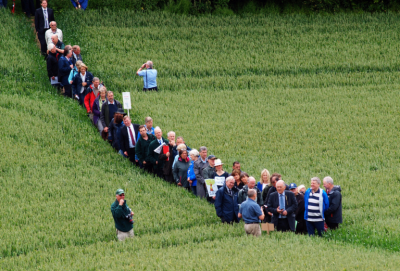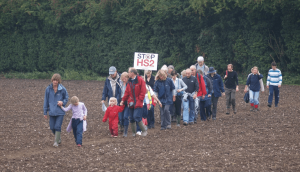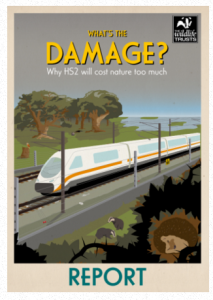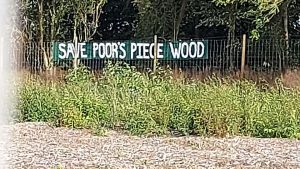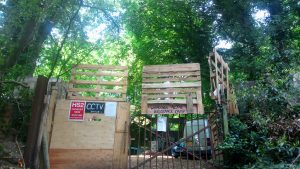Over the last fortnight I have gone down a High Speed 2 research wormhole, sparked by the thought that I hadn’t heard much about what was going on lately with this bloated project. I started to google around and to read the media outside my usual reference points, which led to a fair few discoveries, some good some bad. This is a time of high tension, a time when the white elephant should be retired before it’s too late. With my head full of statistics and controversies, I chatted to friends and families in the park and at barbecues and received a fascinating range of opinions. There are protest camps going on and I visited some of them. There are reports from various groups, for and against, which I have read. I came to realise that Stop HS2is a huge socio-political issue which the mainstream media (and to be fair also the alternative media I tend to read) are simply not covering in all its complexity.
In this article, I’d like to draw attention to a few issues. The judicial review launched by Chris Packham has just failed on appeal and that’s a real shame, but the struggle is far from over. Various court cases are in progress and these people need our support, as well as the camps which are springing up to protect threatened areas of natural beauty. Nobody is against a railway in itself, but the story is far more nuanced than that.
Current situation
What I have realised from talking to people from all walks of life about HS2 these last weeks is that there is still, even after a decade of discussion, massive confusion about what the project actually involves. In the main, the people who know more about HS2 are firmly set against it, for all sorts of reasons, from the economic to the environmental. Very few people are against improving railway infrastructure or linking the North of England to the South, yet it’s not just a railway we are talking about. As the tree protectors know, old farms and woodland will be entirely demolished not for the line itself but for “enabling works”, temporary structures such as access roads. In consequence, it is clear that at every point where people care about their local environment, there will be camps and protests delaying construction as the extent of the devastation HS2 will wreak becomes clear. I would not be surprised if it takes generations to build this stupid project. The Swiss build around mountains, why don’t we build around forest?
Another thing that comes out through talking to people is that many are resigned to HS2 happening. And that is understandable, it’s a massive project and we are ten years in, so it’s hard to keep resisting. When the Tories won the election last year (sigh), Boris commissioned a review of HS2. This was the point at which he could have won support from generations of people in the North by scrapping HS2 and improving Northern transport infrastructure instead. Instead, Douglas Oakervee who was a former head of HS2 Limited (henceforth HS2L) took on the review. Why his job history didn’t immediately invalidate the entire process I don’t know, you could not imagine anyone more unqualified for the task at hand. Surprise surprise, the ex-head of HS2L said that overall, the HS2 project was just grand. The ‘Oakervee Review’ estimated that the cost of HS2 would be between £80.7 billion and £87.7 billion, criticising HS2L for using outdated figures and also warning that the Birmingham – London part (phase 1) “as a standalone scheme does not represent value for money” (quite from page 12). A dissenting report from the review’s deputy chair Tony Berkley put the likely cost at over £107 billion and to be frank that’s an underestimate as well. These analysts have not factored in things like Brexit and the local resistance. Lawyers asking for an injunction in the Colne Valley, west London, said the protests had cost £16 million so far, I don’t really believe that figure but it does give pause for thought. A new camp has just set up at Calvert Jubilee nature reserve, where HS2L want to trash 20% of a well-loved beauty spot. All along the route people will creatively protect their local environment and this will mean massive budget over-runs.
To take the example of Great Missenden, protests there recently focused on the building of a link road. This road is something extraneous to the railway which no-one evaluating the project ten years ago would have seen the need for. Trees were under threat and saved through protests (although regrettably, I did see tweets about HS2L reneging on its promises and some of the trees being chopped down later on). Missenden also saw protests with people forming a chain spanning 100 metres across to show the impact of just how much will be destroyed to build the railway. Instead of the slim clean track shown in the pretty promotional brochures, we have a 100-metre wide trail of destruction plus assorted auxiliary constructions for bentonite factories, gravel pits, crew storage and so on. It really is a megaproject. You can criticise these people as NIMBYs but I’m not from Missenden and I can empathise with this resistance against mission creep.
Which brings me to the compulsory purchases. Parliament has mandated HS2 to compulsory purchase land for the project. And to be fair, compulsory purchase is always necessary to build megaprojects. But when you go to the Jones Hill woods in Wendover and you hear that not just the beautiful woods have been compulsorily purchased, but also the entire farm site so that HS2L can demolish the farm and use it as a building site, despite it being far away from the actual planned railway line, then you start to wonder what gives HS2 the right to rip apart families and communities. I also heard that the purchase money will only be paid on completion of the project, I hope that is just a wild rumour but with this fiasco, anything is possible. In the Colne Valley, a 400-year-old farmhouse will be demolished after a seven-year legal battle! Even dinosaur Tory MPs like Cheryl Gillan (ruler of Amersham and Chesham for three decades and counting) are now dead set against HS2. Of course, she first took care to sell her house which was sitting near the proposed route back in 2011, which led to calls for her to be investigated. She now lives nowhere near the proposed route, and not even in her constituency.
Activists told me that in the Colne Valley, HS2L are chopping down trees to build a temporary road just so they can move a pylon. The implementation of this whole project is deeply flawed. For example, HS2L promises it will plant 7 million new trees. That’s all well and good if it actually happens, if it does (at Harvil the newly planted trees are all dead apparently). But nobody except HS2L would agree that the rich biodiversity of old forest can be replaced by a field of new trees, that would be ludicrous. Even Oakervee stated quite clearly that “planting new woodland is not a direct replacement for removing areas of ancient woodland”. And apparently HS2L are happy to let the trees die and replace them, that’s more cost-effective than actually caring for them. I worry for the owls, they need specific environments to live in, not a grid of newly planted trees. If you go down Harvil Road now, you will see the extent of the devastation. Meanwhile the current chair of HS2L is earning over £660,000 a year, making him the highest-paid official in the UK government!
The Woodland Trust has been plaintively complaining about HS2 for some time now, calling it a “grave threat to the UK’s ancient woods, with 108 at risk of loss or damage.” It also poured scorn on HS2L’s plans to translocate soil from ancient woodlands, saying that such woods are by definition irreplaceable. To add to the mounting environmental concerns, the Wildlife Trusts (a national conglomeration of 46 local trusts) released a report called ‘What’s the Damage? Why HS2 will cost nature too much’. It warns that 693 Local Wildlife Sites (LWS) will be damaged or destroyed by the proposed route of HS2. On top of that, 33 Sites of Special Scientific Interest and 21 Local Nature Reserves will be affected. At the highest level of concern, five sites of international importance for wildlife preservation are at “significant risk”. However many trees HS2L plant, rare sites of biodiversity cannot be recreated by simply clapping our hands.
Resistance
There is of course resistance to the HS2 plans. Stop HS2 has been going for a decade and recently teamed up to form HS2 Rebellion with Extinction Rebellion and local campaigns such as Save Cubbington Woods, Crackley Woods HS2 Protection Camp, Wendover Active Resistance Camp, Denham Ford Protection Camp, Save Roald Dahl Woods, Poor’s Piece Conservation Project and Calvert Reserve Protection Camp. The camps can be found on Facebook under these names. Inevitably, there have been arrests and these people need support!
At Poor’s Piece near Steeple Claydon in Buckinghamshire, seven women stopped HS2L chopping down a 200-year-old oak tree which hosts many animals and insects. For this amazing bit of direct action, they were arrested and held for 12 hours. On 28 July, they appeared in court in Milton Keynes to enter a not guilty plea to the charge of aggravated trespass. Where will the HS2 madness end? Surely this bloated megaproject has to be stopped. The seven women will have their case in January 2021. The tree, which is still standing, gave no comment. Previously, an aggravated trespass case against protestors in the Colne Valley Regional Park collapsed when HS2L were unable to prove they actually owned the land where police had brutally arrested people.
Jellytot is currently on trial for allegedly breaching the conditions of an injunction against protest in Warwickshire. If HS2L succeed in convicting this person, they will be sending a 22-year-old to prison for protecting trees. The mind boggles! I even wonder if Priti Patel will take this opportunity to bring in some even more repressive law against protest … and if we would take that lying down. There has to be a breaking point and I’m starting to see we might be getting close. Academics are warning that covid-19 is exacerbating social tensions (and thanks to the academics for pointing out the bleeding obvious).
Things may look bad right now, but the struggle is far from over. Planning permissions have recently been granted for the megastations at Birmingham Curzon Street and Old Oak Common in London, on the flipside, Hillingdon Council just won a High Court appeal case against HS2L. Winning the appeal means that HS2L will have to pay all costs and also present evidence to the council when making planning applications, instead of attempting to steamroller their way through, so that’s an important victory. Regarding HS2L’s insistence that they could evaluate their own work, the Court of Appeal commented that Parliament had never intended to “set up a scheme which gave the appearance that HS2 Ltd was a judge in its own cause“. This will have an implication for future planning applications!
There are so many more concerns I haven’t even touched on yet. Resources are a big issue. Building HS2 will itself use a huge amount of water for construction and where will that come from? Right now underground aquifers are being affected even by exploratory drilling, which is very worrying for local residents who are asking what will happen when the actual construction starts. On the outskirts of Old Amersham, the beautiful Shardeloes lake turned white recently after HS2L drilled boreholes nearby. A tunnel is planned to go under the lake and what will happen then? Insultingly, the Environment Agency investigation saw no link between the drilling and the pollution, it’s all a bit reminiscent of Cuadrilla denying that the earthquakes in Blackpool were anything at all to do with their exploratory drilling for fracking, before the evidence for that became incontrovertible. The Chess and Misbourne river systems are delicate and construction effects have clearly not been fully assessed. Back in the Colne Valley streams are running white after recent HS2 works and there are concerns for a freshwater aquifer which supplies drinking water for London. We may well end up counting the effects of HS2 in ways we have not even considered yet. Certainly the residents in the Regent’s Park estate next to a mammoth HS2 building site in London, probably did not expect to be plagued by noise problems. There was also an issue with mice until the rats ate all the mice; a woman tells of having to stand on her daughter’s pram when she smokes outside her flat. The assurances given to Camden Council by HS2L are now being challenged. And if you can spare a thought, what about the bats being evicted from trees in Warwickshire without the legally mandated assessments.
The other side
So are there any positive arguments for HS2? Well, there’s a hilarious recent twitter happening where HS2L write a “myth buster thread” and get schooled in the comments. Just like last time in May, when they got taken to task for their lies by the RSPB.
A High Speed Rail Industry Leaders (HSRIL) report from 2019 called ‘HS2 – towards a zero carbon future’ makes an unconvincing case for HS2 playing a leading role in the plans for the UK to become net-zero for greenhouse gas emissions by 2050. It ignores all the current devastation in order to conjure up an idealised future based on cherry-picked examples suggesting high-speed rail will save all our problems. For example, it states that “from 2013 to 2018, a total of just nine trains on HS1 were delayed due to severe weather and seasonal challenges like leaf fall, making it far more reliable than the conventional rail network”, quoting from the Office of Rail and Road’s Annual Report on HS1 Ltd 2018–19. Looking at that same report I can quote back that “The number of train services delayed by incidents attributed to HS1 Ltd worsened this year [2019] – with 478 train services being delayed compared to 245 train services last year.” Without much context a bald quote doesn’t help much except when you are angling to support a certain perspective.
The “independent” writer of the report (an ex-worker at Campaign to Protect Rural England) presumably thinks we need to get better connections to the North which do not involve aeroplanes and cars. So do I, but the devil is in the details and HS2 should have been scrapped by now for other, better planned, initiatives. The very thin conclusion of the HSRIL report says “on very high demand corridors like those that HS2 would serve, high-speed rail has a strong case” and this is true, yet the execution of HS2 has been bad so far and will only get worse, let’s be honest. It’s not just me saying that; last month the Infrastructure and Projects Authority (IPA) gave the scheme its highest risk rating (red). It’s never been rated that highly before, not even during the Carillion scandal (itself worthy of another article).
Conclusion
So what is going to happen? With a heavy heart, I have to say I do believe that HS2 is going to be built. Of course, nothing is set in stone, for example, if the next government is left-wing (and I don’t mean led by that prick Starmer) it might stop the project, but it seems more likely the UK will continue to lurch to the right. If the country ends up in a no-deal Brexit, this might freeze mega-construction projects, but my feeling right now is that HS2 will happen, massively over-budget and very very late. I doubt they will build the later phases of the wings to Manchester and Leeds, so we will be left with a high-speed link from London to Birmingham in thirty years’ time that nobody really uses and which will never recoup the immense amount of money spent on it.
My recent visits to some of the different camps makes it clear that as soon as people realise the project entails compulsory purchasing and huge devastation, there will be more camps, more legal challenges and more disruption, which will slow the project to a crawl. We are already 10 years in and at estimated costs of £100 billion. The mind boggles as to what the future holds. At a time when lockdown has changed the way we behave and climate change concerns have mainstreamed, it beggars belief that a megaproject will be attacking England’s rich flora and fauna for such meagre returns.
I would dare anyone who is currently on the fence about HS2 to pass by a camp and see for themselves what is at stake. This is a time of high tension for high speed. We cannot expect anything from Boris and his cronies, so we have to take action into our own hands, the only way that meaningful change is ever achieved. Maybe this struggle will catalyse a whole new generation of activists like the 1990s road protests did.
As with the No TAV campaign fighting the high-speed line between Lyon and Turin and the Hambach Forest resistance contesting opencast mining in Germany, everything hangs in the balance right now for HS2. On the one side stands mafia construction industries, corrupt businessmen and the arrogant political elite. On the other side, we stand with the local people and the protest camps and the animals and the trees. My last point is that if we were all in the trees right now this bloated project would definitely not be happening.
Source – Freedom News
